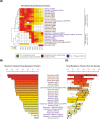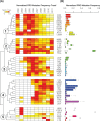A decade of viral mutations and associated drug resistance in a population of HIV-1+ Puerto Ricans: 2002-2011
- PMID: 28493944
- PMCID: PMC5426751
- DOI: 10.1371/journal.pone.0177452
A decade of viral mutations and associated drug resistance in a population of HIV-1+ Puerto Ricans: 2002-2011
Abstract
Puerto Rico has one of the highest rates of HIV/AIDS seen for any US state or territory, and antiretroviral therapy has been a mainstay of efforts to mitigate the HIV/AIDS public health burden on the island. We studied the evolutionary dynamics of HIV-1 mutation and antiretroviral drug resistance in Puerto Rico by monitoring the population frequency of resistance-associated mutations from 2002 to 2011. Whole blood samples from 4,475 patients were analyzed using the TRUGENE HIV-1 Genotyping Kit and OpenGene DNA Sequencing System in the Immunoretrovirus Research Laboratory at Universidad Central del Caribe. Results show that 64.0% of female and 62.9% of male patients had HIV-1 mutations that confer resistance to at least one antiretroviral medication. L63P and M184V were the dominant mutations observed for the protease (PRO) and reverse transcriptase (RT) encoding genes, respectively. Specific resistance mutations, along with their associated drug resistance profiles, can be seen to form temporal clusters that reveal a steadily changing landscape of resistance trends over time. Both women and men showed resistance mutations for an average of 4.8 drugs over the 10-year period, further underscoring the strong selective pressure exerted by antiretrovirals along with the rapid adaptive response of HIV. Nevertheless, both female and male patients showed a precipitous decrease for overall drug resistance, and for PRO mutations in particular, over the entire course of the study, with the most rapid decrease in frequency seen after 2006. The reduced HIV-1 mutation and drug resistance trends that we observed are consistent with previous reports from multi-year studies conducted around the world. Reduced resistance can be attributed to the use of more efficacious antiretroviral drug therapy, including the introduction of multi-drug combination therapies, which limited the ability of the virus to mount rapid adaptive responses to antiretroviral selection pressure.
Conflict of interest statement
Figures






Similar articles
-
Prevalence of drug resistance and associated mutations in a population of Hiv-1+ Puerto Ricans in 2005.Bol Asoc Med P R. 2010 Jul-Sep;102(3):13-7. Bol Asoc Med P R. 2010. PMID: 23875516 Free PMC article.
-
Prevalence of drug resistance and associated mutations in HIV-positive Puerto Ricans: sex variations.Ethn Dis. 2008 Spring;18(2 Suppl 2):S2-132-6. Ethn Dis. 2008. PMID: 18646335
-
Prevalence of Drug Resistance and Associated Mutations in a Population of HIV-1(+) Puerto Ricans: 2006-2010.AIDS Res Treat. 2012;2012:934041. doi: 10.1155/2012/934041. Epub 2012 Apr 24. AIDS Res Treat. 2012. PMID: 22593823 Free PMC article.
-
Study of the impact of HIV genotypic drug resistance testing on therapy efficacy.Verh K Acad Geneeskd Belg. 2001;63(5):447-73. Verh K Acad Geneeskd Belg. 2001. PMID: 11813503 Review.
-
Rates of transmission of antiretroviral drug resistant strains of HIV-1.J Clin Virol. 2003 Feb;26(2):153-61. doi: 10.1016/s1386-6532(02)00114-2. J Clin Virol. 2003. PMID: 12600647 Review.
Cited by
-
Molecular Epidemiology of HIV-1 Virus in Puerto Rico: Novel Cases of HIV-1 Subtype C, D, and CRF-24BG.AIDS Res Hum Retroviruses. 2018 Jun;34(6):507-516. doi: 10.1089/AID.2017.0305. Epub 2018 May 23. AIDS Res Hum Retroviruses. 2018. PMID: 29658302 Free PMC article.
-
Short Communication: Integrase Strand Transfer Inhibitors Drug Resistance Mutations in Puerto Rico HIV-Positive Individuals.Int J Environ Res Public Health. 2021 Mar 8;18(5):2719. doi: 10.3390/ijerph18052719. Int J Environ Res Public Health. 2021. PMID: 33800269 Free PMC article.
References
-
- Office of Epidemiological Research. Puerto Rico HIV/AIDS Surveillance Summary Cumulative HIV/AIDS Cases Diagnosed as of April 30, 2016. Puerto Rico Health Department; 2016. February 29, 2016. Report No.
-
- Centers for Disease Control and Prevention. HIV/AIDS Surveillance Report 2002. 2002.
-
- Centers for Disease Control and Prevention. HIV/AIDS Surveillance Report 2011. 2011 February 2013. Report No. - PubMed
-
- Ulett KB, Willig JH, Lin HY, Routman JS, Abroms S, Allison J, et al. The therapeutic implications of timely linkage and early retention in HIV care. AIDS Patient Care STDS. 2009;23(1):41–9. PubMed Central PMCID: PMC2733237. doi: 10.1089/apc.2008.0132 - DOI - PMC - PubMed
-
- Cohen MS, Chen YQ, McCauley M, Gamble T, Hosseinipour MC, Kumarasamy N, et al. Prevention of HIV-1 infection with early antiretroviral therapy. N Engl J Med. 2011;365(6):493–505. PubMed Central PMCID: PMC3200068. doi: 10.1056/NEJMoa1105243 - DOI - PMC - PubMed
MeSH terms
Substances
Grants and funding
LinkOut - more resources
Full Text Sources
Other Literature Sources

